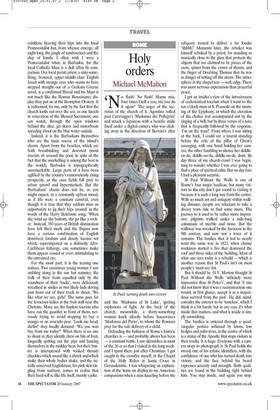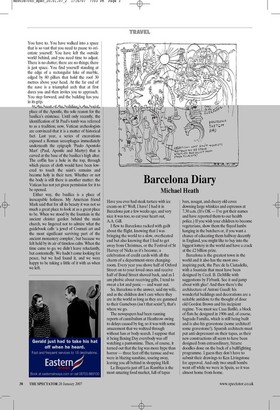Holy orders
Michael McMahon ,N o flash! No flash! Mama mia, four times I tell-a you, ma you do it again!' The anger of the sacristan of the church of S. Agostino rolled past Caravaggio's 'Madonna dei Pellegrini' and struck a Japanese with a beatific smile fixed under a digital camera who was clicking away in the direction of Bernini's altar and the 'Madonna of St Luke', igniting explosions of light. At the back of the church, meanwhile, a thirty-something woman knelt silently before Sansovino's 'Madonna del Parto', to whom the Romans pray for the safe delivery of a child.
Defending the holiness of Rome's historic churches is — and probably always has been — a constant battle. I saw skirmishes in most of the 20 or so that I visited in the long weekend I spent there just after Christmas. I got caught in the crossfire myself, in the Chapel of the Holy Relics in Santa Croce in Gerusalemme. I was whispering an explanation of the items on display to my American companions when a man kneeling before the reliquary turned to deliver a far louder `Shhhh!' Moments later, the rebuker was himself rebuked by a priest, for standing so manically close to the glass that protects the objects that are claimed to be pieces of the cross, spines from the crown of thorns, and the finger of Doubting Thomas that he was in danger of setting off the alarm. The atmosphere in the chapel was — well, edgy. There was more nervous expectation than prayerful peace.
I got an insider's view of the intrusiveness of ecclesiastical tourism when I went to the ten o'clock mass at S. Prassede on the morning of the Epiphany, at which the elevation of the chalice was accompanied not by the ringing of a bell, but by three verses of a tune that is frequently followed by the response, 'I'm on the train!' From where I was sitting at the back, I could see a tourist standing before the relic of the pillar of Christ's scourging, with one hand holding her camera, the other fumbling to silence her diddleoo-da, diddle-oo-da, diddle-oo-da, dum. By day three of my church-crawl I was beginning to wonder whether I was ever going to find a place of spiritual calm. But on day four I had a pleasant surprise.
St Paul Without the Walls is one of Rome's four major basilicas, but many visitors to the city don't get round to visiting it because it is such a long way from the centre. With so much art and antiquity within walking distance, people are reluctant to take a dreary tram ride to find some more. The journey to it used to be rather more impressive: pilgrims walked under a mile-long colonnade of marble and stone. But the walkway was wrecked by the Saracens in the 9th century, and now not a trace of it remains. The basilica that it led to nearly went the same way in 1823, when clumsy workmen started a fire that destroyed the roof and three sides of the building. Most of what one sees today is a rebuild — which is another reason that St Paul's isn't on most people's 'must-see' list.
But it should be. H.V. Morton thought St Paul Without the Walls 'infinitely more impressive than St Peter's', and that 'if one did not know that it was a reconstruction one would, at first glance, accept it as a stupendous survival from the past'. He did, mind, consider the exterior to be 'tasteless', which I think is a bit harsh; but in any case it's what inside that matters, and what is inside is simply astonishing.
The basilica is entered through a quadrangular portico softened by lawns, low hedges and palm trees, in the centre of which is a statue of the Apostle that stops visitors in their tracks. It is huge. Everyone with a camera stops to photograph it. St Paul holds the sword, one of his artistic identifiers, with the confidence of one who has turned death into victory, and the face behind his beard expresses serenity and strength. Both qualities are found in the building right behind him You step inside, and again you stop.
You have to. You have walked into a space that is so vast that you need to pause to orientate yourself. You have left the outside world behind, and you need time to adjust. There is no clutter; there are no things; there is just space. You find yourself standing at the edge of a rectangular lake of marble, edged by 80 pillars that hold the roof 30 metres above your head. At the far end of the nave is a triumphal arch that at first dares you and then invites you to approach. You step forward, and the building has you in its grin t th place of the Apostle, the sole reason for the basilica's existence. Until only recently, the identification of St Paul's tomb was referred to as a tradition; now, Vatican archeologists are convinced that it is a matter of historical fact. Last year, a series of excavations exposed a Roman sarcophagus immediately underneath the epigraph 'Paulo Apostolo Mart' (Paul, Apostle and Martyr) that is carved at the base of the basilica's high altar. The coffin has a hole in the top, through which pieces of cloth would have been lowered to touch the saint's remains and become holy in their turn. Whether or not the body is still there is another matter: the Vatican has not yet given permission for it to be opened.
Either way, the basilica is a place of inescapable holiness. My American friend Mark said that for all its beauty it was not so much a great place to look at as a great place to be. When we stood by the fountain in the ancient cloister garden behind the main church, we lingered not to admire what the guidebook calls 'a jewel of Cosmati art and the most significant surviving part of the ancient monastery complex', but because we felt held by its air of timeless calm. When the time came to go, we didn't leave reluctantly, but contentedly. We hadn't come looking for peace, but we had found it, and we were happy to be taking a little of it with us when we left.






















































 Previous page
Previous page